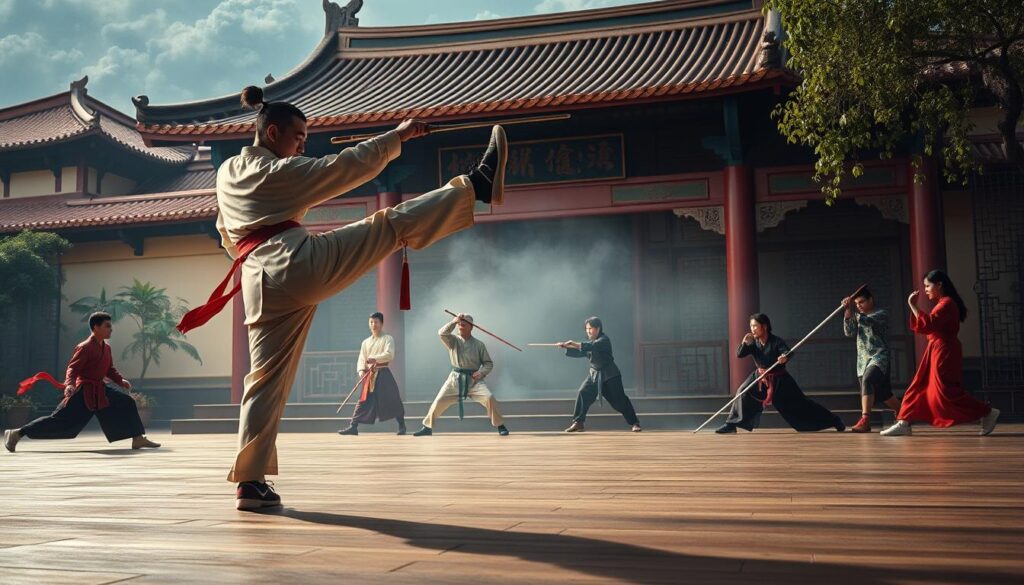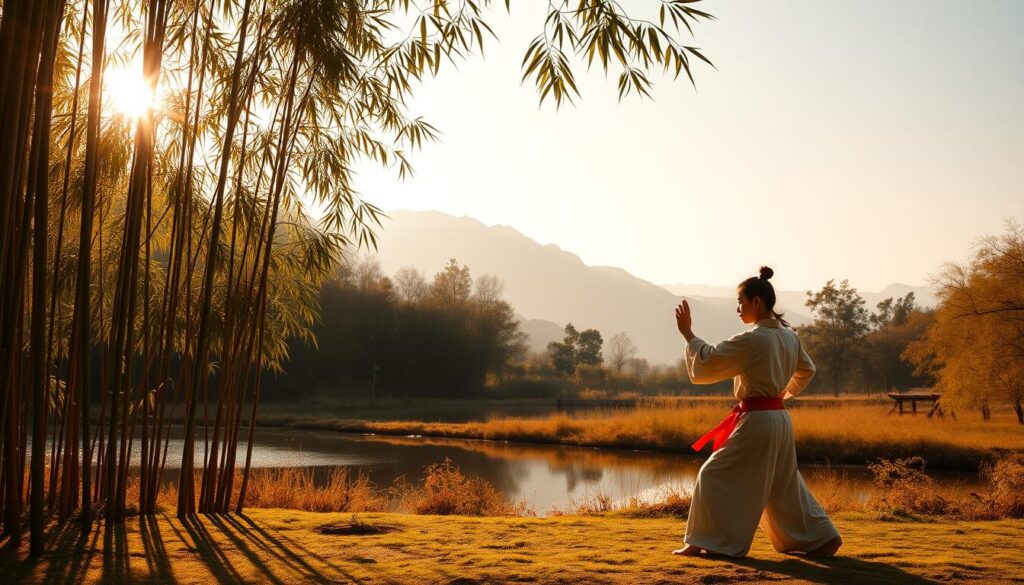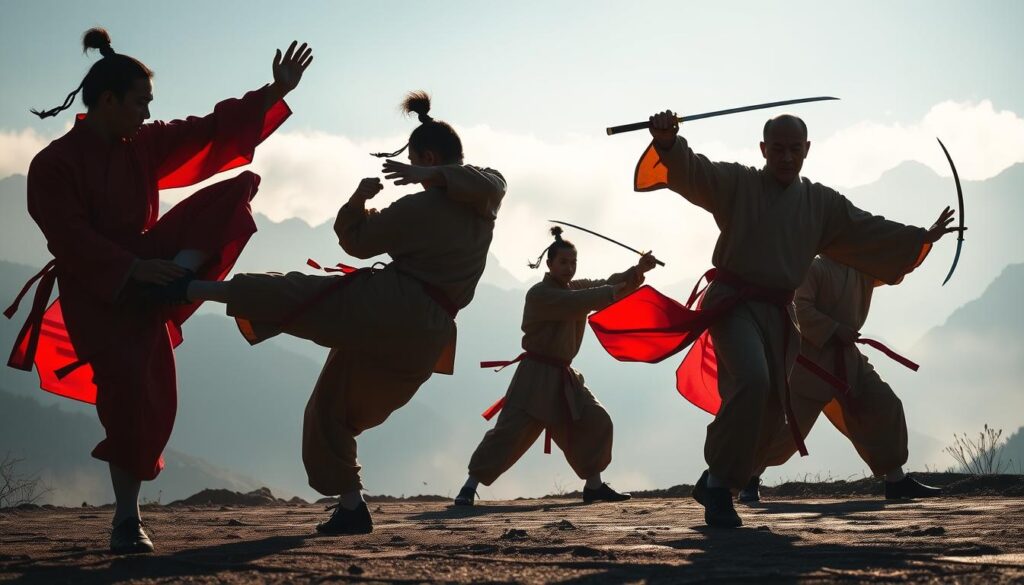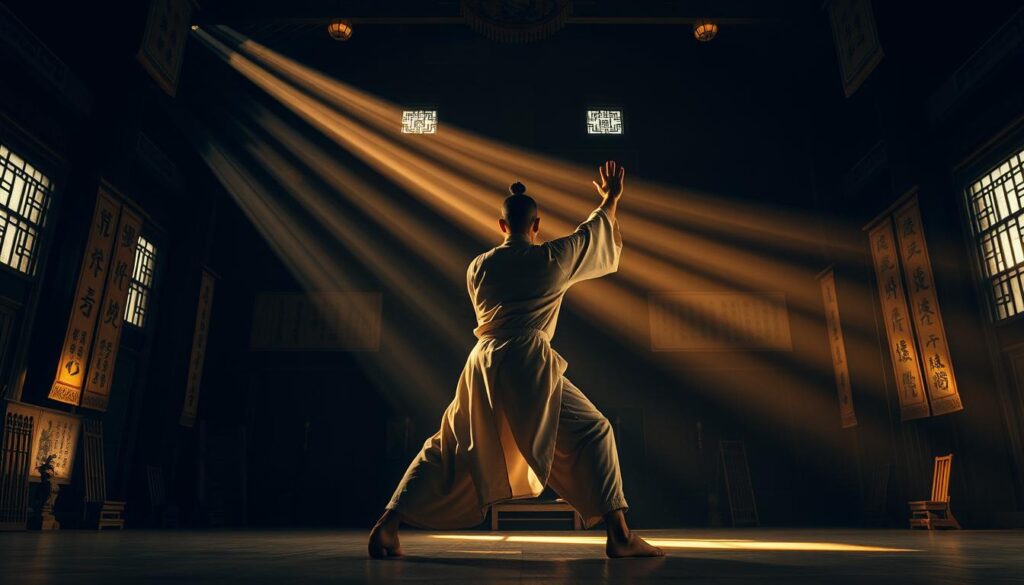Exploring Chinese martial arts, you’ll find a deep history and philosophy in wushu. This art has been around for thousands of years. It’s not just for fighting but also for health and spirit.
Learning traditional Chinese martial arts, you’ll see the techniques and principles passed down. Wushu and traditional martial arts are closely tied. You’ll learn about discipline, focus, and self-control in wushu.
Introduction to Wushu
Wushu is a traditional Chinese martial art shaped by history and culture. Studying wushu history and martial arts is rewarding. It gives you a peek into China’s rich culture.
Key Takeaways
- Wushu history spans thousands of years and is deeply intertwined with Chinese culture and philosophy.
- Traditional Chinese martial arts, including wushu, offer physical, mental, and spiritual benefits.
- Discipline, focus, and self-control are essential principles in wushu training.
- Wushu has evolved over time, influenced by various dynasties and cultural practices.
- Studying wushu history and traditional Chinese martial arts can provide insights into China’s rich cultural heritage.
- Wushu is a unique and fascinating subject that offers a wealth of knowledge and understanding.
Understanding the Origins of Chinese Martial Arts
Exploring Chinese martial arts takes you back to ancient China. It was shaped by military needs, philosophy, and culture. The wushu philosophy combines physical skill, mental focus, and spiritual growth.
The history of Chinese martial arts shows how military and civilian needs merged. Ancient China’s military needs led to martial arts as a defense tool. At the same time, Chinese culture and philosophy made martial arts a way of life. It focused on inner energy, balance, and harmony.

- The influence of Taoist and Buddhist philosophies on the development of martial arts
- The role of martial arts in Chinese military history, including the famous warriors of the Qin and Han dynasties
- The evolution of different martial arts styles, such as Shaolin Kung Fu and Tai Chi, each with its unique techniques and principles
Learning about the wushu philosophy and martial arts history of Chinese martial arts is key. It helps you see the depth and value of this ancient practice. You’ll understand its physical, mental, and spiritual benefits better.
The Art of Wushu: An Introduction to the History, Philosophy, and Techniques of Traditional Combat
Wushu is a traditional Chinese martial art with a rich history and philosophy. It aims to improve both physical and mental health. It also teaches self-defense.
Wushu combines physical movements like stances, punches, and kicks. These help improve flexibility, balance, and fitness.
At its core, wushu has martial arts techniques passed down through generations. These techniques help in combat and improve discipline, focus, and self-control. Mastering wushu techniques boosts physical abilities and mental clarity.
- Stances: These are the foundation of wushu, providing a strong base for all movements.
- Punches and kicks: These are used to develop power, speed, and agility.
Practicing wushu reveals its beauty and elegance. It emphasizes discipline, focus, and self-control. Wushu is great for improving health and well-being.

Wushu combines physical movement with mental discipline. It offers a holistic approach to martial arts training. Exploring wushu reveals its many benefits, from physical fitness to mental clarity. With its rich history and techniques, wushu is a great choice for improving health and well-being.
Fundamental Principles of Wushu Training
Wushu’s philosophy is all about balance and harmony. It’s not just about moving your body. It’s also about building internal energy, called Qi. This energy flows through you, guiding your actions and connecting you to the world.
Wushu training combines internal and external styles. Internal styles work on Qi, while external styles focus on physical movements. Learning both helps you grow in body and mind.

- Energy cultivation: This involves practices such as meditation and breathing exercises to cultivate and balance Qi.
- Basic stances and movements: These are the foundation of Wushu, providing a strong base for more advanced techniques.
- Internal vs external styles: Understanding the differences between internal and external styles can help you develop a more comprehensive practice.
Embracing Wushu’s philosophy and techniques can deepen your understanding. It helps you build a stronger, more balanced practice. Remember, Wushu is about more than just physical movements. It’s about connecting with yourself and the world.
The Philosophical Foundations of Chinese Martial Arts
Exploring Chinese martial arts reveals the key role of martial arts philosophy. This philosophy is based on ancient texts and studies on ethics and morals. It shapes not just the techniques but also the mindset and character of practitioners. This leads to a complete approach to personal growth.
Chinese martial arts focus on the connection between body, mind, and spirit. Martial arts philosophy teaches the value of internal energy, balance, and harmony. It guides practitioners to train with mindfulness and discipline. This helps them understand themselves and the world better.
The main principles of martial arts philosophy are:
- Respect and discipline
- Self-awareness and self-control
- Balance and harmony
- Perseverance and dedication

By following these principles, martial arts practitioners go on a journey of self-discovery. As you dive into Chinese martial arts, remember that martial arts philosophy is more than theory. It’s a living guide for becoming stronger, wiser, and more compassionate.
Major Styles and Schools in Traditional Wushu
Exploring traditional Chinese martial arts, you find many styles and schools. Wushu history shows how different forms evolved. Each has its own way and beliefs.
At the core are Northern and Southern styles. The Northern style is all about strong kicks and complex footwork. The Southern style focuses on hand skills and quick movements. Shaolin Kung Fu and Tai Chi also shape traditional Chinese martial arts.
Regional Variations
- Northern style: emphasizes powerful kicks and intricate footwork
- Southern style: focuses on hand techniques and agile movements
- Shaolin Kung Fu: known for its holistic approach to martial arts training
- Tai Chi: emphasizes slow, flowing movements and inner balance
Traditional Chinese martial arts keep growing. New forms have come up, mixing old and new. Learning about wushu history helps us understand these changes. By diving into different styles, we see the art’s deep meaning in Chinese culture.

Essential Techniques and Training Methods
Exploring wushu means learning its wushu techniques. These include stances, movements, and patterns. They help improve your body and mind. Mastering these martial arts techniques boosts your performance and understanding of wushu.
Key techniques and training methods in wushu are:
- Forms: These are set patterns of movement. They help improve your technique and balance.
- Sparring: It’s a way to practice using wushu techniques in a safe setting.
- Conditioning exercises: These physical workouts boost strength, flexibility, and endurance.
Using these wushu techniques and training methods builds a strong base. It improves your skills in martial arts techniques. Always practice with patience and dedication. Learning wushu takes time and effort.
The Role of Mental Cultivation in Wushu Practice
As you explore Wushu, you’ll see mental cultivation is key. It’s not just about learning moves. It’s about growing your mind and spirit too. The philosophy of Wushu values mental discipline, focus, and self-awareness. Adding meditation and mindfulness to your training boosts your skills and deepens your understanding of Wushu techniques.
Wushu philosophy centers on balance between body and mind. A strong mind helps you move better and stay balanced. This builds a strong character and helps follow traditional values. Key parts of mental growth in Wushu are:
- Meditation: quieting the mind and focusing on the present moment
- Mindfulness: being fully aware of your thoughts, emotions, and actions
- Character development: cultivating virtues such as respect, discipline, and self-control
Embracing Wushu’s mental side unlocks its true power. Remember, Wushu is more than physical training. It’s a way to grow personally and cultivate yourself. By living Wushu philosophy every day, you’ll become stronger, more balanced, and kinder.
Modern Applications and Benefits of Wushu Training
Exploring martial arts, you might ask how traditional chinese martial arts like Wushu help today. Wushu’s deep martial arts history brings a special way to stay fit, calm your mind, and grow as a person.
Wushu training offers many perks, such as:
- Improved physical fitness and coordination
- Enhanced mental focus and discipline
- Reduced stress and anxiety
- Increased self-confidence and self-awareness
Wushu is more than just moving your body. It also teaches the deep values of traditional chinese martial arts. This way, it helps you feel whole and balanced. Adding Wushu to your life can boost your health and clear your mind.
If you’re into martial arts history or want a new workout, Wushu is great. It’s modern and meets today’s needs. Wushu is a smart choice for anyone looking to improve their fitness or personal growth.
Conclusion: Embracing the Legacy of Chinese Martial Arts
As you’ve learned, wushu history, wushu philosophy, and wushu techniques are more than just fighting skills. They are a deep way to grow and find yourself. Chinese martial arts mix mind, body, and spirit in a special way.
By diving into Wushu, you start a journey to wellness and peace. It teaches you to control your energy, be mindful, and follow old values. These lessons can make your life richer and help you feel more connected.
Exploring Wushu can change you in many ways. You might learn new forms, meditate, or understand its deep ideas. This journey can make you stronger, not just physically, but in spirit too.
We encourage you to start this exciting journey of Wushu. It’s a mix of old and new that can empower you. Let Chinese martial arts help you understand yourself and the world better.

